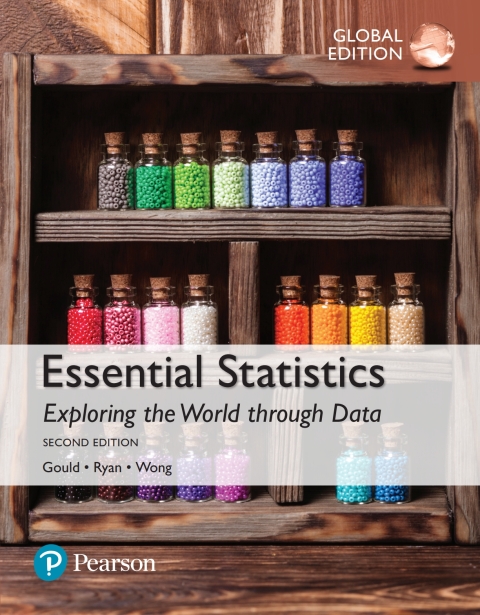Description
Efnisyfirlit
- Title Page
- Copyright Page
- Dedication
- About the Authors
- Contents
- Preface
- Acknowledgments
- Index of Applications
- Chapter 1: Introduction to Data
- Case Study: Deadly Cell Phones?
- 1.1. What Are Data?
- 1.2. Classifying and Storing Data
- 1.3. Organizing Categorical Data
- 1.4. Collecting Data to Understand Causality
- Exploring Statistics: Collecting a Table of Different Kinds of Data
- Chapter 2: Picturing Variation with Graphs
- Case Study: Student-to-Teacher Ratio at Colleges
- 2.1. Visualizing Variation in Numerical Data
- 2.2. Summarizing Important Features of a Numerical Distribution
- 2.3. Visualizing Variation in Categorical Variables
- 2.4. Summarizing Categorical Distributions
- 2.5. Interpreting Graphs
- Exploring Statistics: Personal Distance
- Chapter 3: Numerical Summaries of Center and Variation
- Case Study: Living in a Risky World
- 3.1. Summaries for Symmetric Distributions
- 3.2. What’s Unusual? The Empirical Rule and z-Scores
- 3.3. Summaries for Skewed Distributions
- 3.4. Comparing Measures of Center
- 3.5. Using Boxplots for Displaying Summaries
- Exploring Statistics: Does Reaction Distance Depend on Gender?
- Chapter 4: Regression Analysis: Exploring Associations between Variables
- Case Study: Catching Meter Thieves
- 4.1. Visualizing Variability with a Scatterplot
- 4.2. Measuring Strength of Association with Correlation
- 4.3. Modeling Linear Trends
- 4.4. Evaluating the Linear Model
- Exploring Statistics: Guessing the Age of Famous People
- Chapter 5: Modeling Variation with Probability
- Case Study: SIDS or Murder?
- 5.1. What Is Randomness?
- 5.2. Finding Theoretical Probabilities
- 5.3. Associations in Categorical Variables
- 5.4. Finding Empirical Probabilities
- Exploring Statistics: Let’s Make a Deal: Stay or Switch?
- Chapter 6: Modeling Random Events: The Normal and Binomial Models
- Case Study: You Sometimes Get More Than You Pay For
- 6.1. Probability Distributions Are Models of Random Experiments
- 6.2. The Normal Model
- 6.3. The Binomial Model (optional)
- Exploring Statistics: ESP with Coin Flipping
- Chapter 7: Survey Sampling and Inference
- Case Study: Spring Break Fever: Just What the Doctors Ordered?
- 7.1. Learning about the World through Surveys
- 7.2. Measuring the Quality of a Survey
- 7.3. The Central Limit Theorem for Sample Proportions
- 7.4. Estimating the Population Proportion with Confidence Intervals
- 7.5. Comparing Two Population Proportions with Confidence
- Exploring Statistics: Simple Random Sampling Prevents Bias
- Chapter 8: Hypothesis Testing for Population Proportions
- Case Study: Dodging the Question
- 8.1. The Essential Ingredients of Hypothesis Testing
- 8.2. Hypothesis Testing in Four Steps
- 8.3. Hypothesis Tests in Detail
- 8.4. Comparing Proportions from Two Populations
- Exploring Statistics: Identifying Flavors of Gum through Smell
- Chapter 9: Inferring Population Means
- Case Study: Epilepsy Drugs and Children
- 9.1. Sample Means of Random Samples
- 9.2. The Central Limit Theorem for Sample Means
- 9.3. Answering Questions about the Mean of a Population
- 9.4. Hypothesis Testing for Means
- 9.5. Comparing Two Population Means
- 9.6. Overview of Analyzing Means
- Exploring Statistics: Pulse Rates
- Chapter 10: Analyzing Categorical Variables and Interpreting Research
- Case Study: Popping Better Popcorn
- 10.1. The Basic Ingredients for Testing with Categorical Variables
- 10.2. Chi-Square Tests for Associations between Categorical Variables
- 10.3. Reading Research Papers
- Exploring Statistics: Skittles
- Appendix A: Tables
- Appendix B: Check Your Tech Answers
- Appendix C: Answers to Odd-Numbered Exercises
- Appendix D: Credits
- Index
- Back Cover






Reviews
There are no reviews yet.